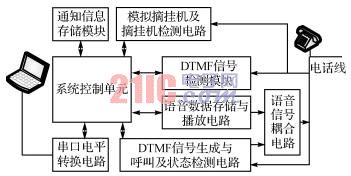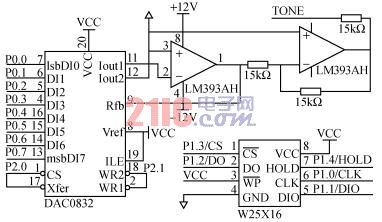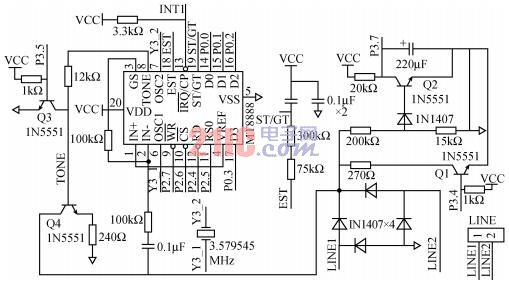introduction
This article refers to the address: http://
As we all know, various departments often have important things to be notified. It is good to have a meeting, but it is time consuming; if you send a message, sometimes it is not clear enough. The best way is to call to notify, save the time of the notified person, and be able to express the information clearly, but it is also a nuisance to ask the staff to call everyone one by one. In this case, it is necessary to develop a telephone notification system that can realize automatic notification without human control.
Currently, most similar notification systems are based on CTI cards [1]. Such a system requires real-time control by a computer to enable dialing and playback of notification voices, so the computer needs to be turned on when the notification task is implemented, which is not conducive to notification when the off-hours or holidays are unattended. In this paper, an automatic telephone notification system consisting mainly of offline telephone automatic notification devices is designed, and the notification process does not require real-time management by the PC.
1 overall system design
The system consists of the upper machine automatic notification control software and the lower machine offline telephone automatic notification device. Among them, the upper computer automatic notification control software mainly completes the management of the telephone number and the notification information, and it is only an information management system, and the work of the specific telephone notification is automatically and independently completed by the offline telephone automatic notification device.
As shown in FIG. 1 , the offline telephone automatic notification device is mainly composed of a notification information storage module, a voice data storage and playback circuit, a telephone call and status detection module, a DTMF signal detection module, a serial communication, and a system control module. The notification information storage module is configured to complete the storage of the notification information (including the notified telephone number, the notification voice and the prompt sound storage, and the current notification status information), and the hardware mainly uses the serial port flash memory chip to implement; the voice data storage and playback The circuit is used to complete the D/A conversion of the voice information, and then the audio signal is coupled to the telephone line through the voice signal coupling circuit; the telephone call and status detection module is used to complete the dialing of the telephone number and the detection of the call state, In the judgment of the answering state, which includes the DTMF signal generation and call and state detection circuit (completed using the DTMF codec chip), the analog hooking circuit and the hook detecting circuit; the DTMF signal detecting module is used to detect the dialing of the call and play the notification voice. In the process, the receiving party presses the confirm button (using another DTMF codec chip); the serial communication and system control module is composed of a serial port level conversion circuit and a control unit composed of MCS51 series MCU (AT89S52), which is used to complete Notification process control and data communication.

Figure 1 Block diagram of offline telephone automatic notification device
2 voice data storage and playback circuit
The telephone notification information is mainly composed of telephone number data and voice information encoded data. Among them, the telephone number data is ASCII code, and the amount of information is not much; the voice information encoded data uses the PCM encoding format, and other compression encoding forms may also be used. If compression coding is used, the MCU program must also design the corresponding decoding program, which will increase the execution load of the MCU. Therefore, it is recommended to use the PCM encoding format.

Figure 2 voice data storage and playback circuit
The voice data storage and playback circuit is shown in Figure 2. In view of the low voice quality requirements of the telephone system [2], this paper uses 8-bit quantized bits and 8 kHz sampling frequency, so its data volume is not large, and the 2-minute voice data volume is 1×8000×120. =960000 B, plus the 1 MB flash used for phone number information, the system uses 16 Mb (2 MB) of flash memory to meet the phone notification requirements. Here, the SPI interface flash chip W25X16 [3] is used. Since the AT89S52 does not have an SPI interface, the P1 port is used to simulate the SPI port to communicate with the W25X16 through software.
The MCU reads the voice data in the flash memory W25X16 through the P1 line, transmits it to the D/A converter DAC0832 through the P0 port at 8000 Hz, and performs voice restoration output. The analog voice is sent after the current and voltage conversion through the amplifier LM393AH. To the voice signal coupling circuit input line TONE, the voice signal is coupled to the telephone line, thereby realizing voice playback of the telephone notification.
3 DTMF signal generation and call and status detection circuit
The DTMF signal generation and call and status detection circuit is shown in Figure 3. The telephone number to be dialed by the upper computer and the voice of the telephone to be broadcasted are sent to the MCU through the serial port, and stored in the flash chip W25X16, the MCU will initiate the automatic telephone notification process. Read the phone number to be dialed from the W25X16. The system sets P3.4 to high level and performs analog off-hook. After the system detects that the off-hook state is valid through P3.7, the BCD code of each phone number data is sent to the D0~D3 data line of MT8888, and the WR and CS signals are valid, and the DTMF coding circuit of MT8888 can be written. . According to the BCD code continuously written by the MCU, the MT8888 continuously sends out the corresponding DTMF signal through the TONE pin, and then couples the audio signal to the telephone line via the voice signal coupling circuit [4] composed of Q1 and Q2, and transmits it to the program-controlled switch. Software dialing.

Figure 3 DTMF signal generation and call and status detection circuit
After the dialing is completed, the MCU sets the MT8888 to work in the call listening mode to perform call state monitoring. The MT8888 transmits signals through the 2-pin detection telephone line. The MCU can analyze the call status by reading the pulse frequency and the number of pulses output from the IR8/CP pin of the MT8888. If the 450 Hz audio signal is transmitted on the line, and it is a loop signal that is not available for 4 s after 1 s, it is the ring back tone signal, that is, it is in the ringing state; if the line transmits 450 Hz audio signal, Moreover, the 0.35 s through 0.35 s break cycle signal is a busy tone signal, that is, the line is busy or on-hook.
In the voice broadcast process, the system also uses another DTMF detection circuit composed of MT8888 chip to detect the key action of the current telephone receiver to determine whether it presses the confirmation button. The system saves the status of this call or notification according to the button status.
4 PC control software design
The upper computer control software mainly includes: an electronic business card management module, which can complete the management of the contact basic information and the telephone number (including functions such as adding, deleting, and checking); the business card grouping management module; the telephone notification information management module, having the notification voice recording, The function of selecting the notified object (ie, the telephone number) and downloading the data to the offline notification device; the notification information inquiry module can complete the notification of the notification status and the compensation control, and can also query the current or historical notification content and status.
The telephone notification information and the notification instruction are from the upper computer control software. After the pre-notified telephone number and voice data are marked as the notification command data packet, the upper computer sends the lower-level machine through the serial port, so that the lower computer starts the offline automatic notification from the computer management. process. In addition, the host computer can also send a notification status command packet, and the serial communication interrupt service program completes the upload task of the current notification state.
4 is a processing flow of an offline telephone automatic notification device. The offline automatic notification device is powered on, and after performing necessary initialization, it is determined whether the automatic notification process is started by notifying the status flag. The notification flag is set by the interrupt service program according to the received command packet. If it is "true", the device proceeds to the notification process, otherwise it continues to query the status flag. After entering the notification process, the first telephone number of the pre-notification is read first, and then the analog off-hook is prepared to dial. In order to reliably implement the off-hook, it is required to judge the off-hook state before and after off-hook. Only when the machine is on-hook can the off-hook be picked up, and the off-hook can be dialed after it is valid. After the MCU controls the dialing, the voice data is read from the flash memory and sent to the D/A converter at a frequency of 8000 Hz to play the notification voice. In the process of playing the notification voice, the DTMF signal detection module monitors the DTMF signal on the line to determine whether the answering sender has pressed the confirmation button to perform the answer confirmation. If confirmed, the system will save the notification status, otherwise notify the loop and repeat the notification. When a call is notified, the system continues to read the next pre-notification phone number and notifies the next call until all notifications are confirmed or the number of repeated notifications is exceeded.
Conclusion
According to the characteristics of the telephone notification system, this paper designs an automatic telephone notification system without real-time control of the PC. The PC in the system only plays a role of information management. The specific telephone notification is automatically completed by the offline telephone automatic notification device. The work 77 does not require real-time management or control of the PC. It is an offline notification device, which can be implemented at work. Telephone notification in the state of the PC machine can improve the use efficiency of the phone and save energy consumption.

Figure 4 offline phone automatic notification processing flow
LED Power Supply, CCTV center power supply device, LCD display power supply.
We can meet your specific requirement of the products, like label design. The plug type is US/UK/AU/EU. The material of this product is PC+ABS. All condition of our product is 100% brand new. OEM and ODM are available in our company, and you deserve the best service. You can send more details of this product, so that we can offer best service to you!
Power Supply,5V Power Supply,12V Power Supply, 24V Power Supply
Shenzhen Waweis Technology Co., Ltd. , http://www.waweis.com